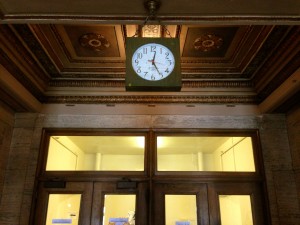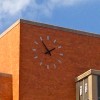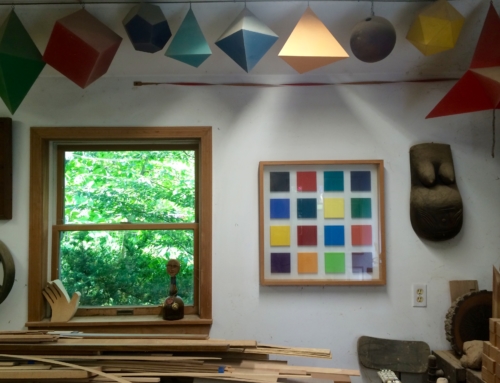Analog clocks—I love them. I photographed these last weekend. Anybody recognize them?
When you look at the hands and face of an analog clock you're looking at the past, present, and future, at once: a half day, so to speak, at least a kind of map of a half day. The hands (which are really more like arms) sweep around the face (which has its features, when it has them—numerals or dashes or, say, songbirds—arranged around the outside edge). In comparison, the little lit green numerals on our stovetop are as ineloquent as the fake clicks of our smart phones.
Telling time with a digital clock seems a little bit to me like navigating via a map on a smart phone, useful enough, but constraining. One closes down time. The other closes down space.
Funny how much context matters. Seven hundred or so years ago, when churches began building some of the earliest analog clocks in towers, of steel, they accelerated the growth of time consciousness. As it was the Middle Ages, however, the main impetus was to signal that it was time to pray: in other words, to pause. By the Industrial Revolution, however, clocks were akin to slave drivers, especially for the human cogs in the machine.
Today, timepieces are practically necessities of life. When our daughter was learning to tell time, we did tuck our digital clocks away. Her very first bedside clock was pink plastic with an illuminated ivory face—a full moon in a sunset sky. We hoped she'd grow up knowing how to read analog clocks at a glance. She did.
Add a y to analog, and you've got analogy—a strictly human concept, one that cannot exist without imagination. What (so-called) anachronism sparks your imagination?











Alison,
I love this! Keep posting your writings as it gives me a reason to take time out of my busy days and always makes me smile! I just wish I would have thought about putting our digital clocks away…..1 of my 3 girls can readily read an analog clock. It bothers me as much as it bothers them that I still do not and will not switch to a smart phone 🙂
Have a great weekend!
Kathy
I have an antique smart phone. It is so s l o w (according to Sophie, I "deserve a new one"). But how fast do we need to go, really?
How did the contemplative tick-tock come to be? A possible origin played on Nova this past week called "Ancient Computer." The history is amazing on several accounts. A mysterious device was discovered encrusted and in partial fragments off the coast of Greece over 100 years ago and has become known as the "antikythera mechanism". One astonishing aspect is that the tiny brass gears were built in the first place–so sophisticated some thought it wasn't related to the Greek relics it was found with but dropped overboard centuries later. Just the last couple years diverse talents have been able to reverse engineer and figure out how it worked and what the thing was used for. The ancients were able to solve the complicated math of planetary movements and produce mechanical devices (mechanism/computer) that reproduced the elliptical motion of the moon and other objects to an accuracy of 8 decimal points and predicted celestial events centuries into the future. This knowhow was lost since no other such device has ever turned up until the much simpler astrolabes, then "clocks" centuries hence. Ancient time constructed, lost, then re-constructed in our time makes my innards tick-tock.
Wikipedia has a good overview with links of the the antikythera mechanism.
Wikipedia has a good overview with links of the the antikythera mechanism.
Interesting stuff. It occurs to me there's a whole essay here. At least I got this much down. I heard about someone I know who hates analog speedometers. First chance I get, I'm going to ask him why.